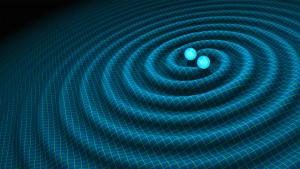Post
Gravity Waves
11 February 2012
 R. Hurt/Caltech-JPL
R. Hurt/Caltech-JPLWhen most people think of waves they typically think of water waves. Drop a pebble in a calm pond and you can watch the waves spread out over the surface of the water. Waves occur in water because it takes time for the water displaced by the pebble to push against the surrounding water. The displaced water moves outward, which pushes water further out, which pushes water even further out, and so on. The energy of the displacement moves through the water at a particular speed. That “speed of water” varies depending on the depth of the water and other factors, but it is never instantaneous.
Light waves (electromagnetic waves for those who like precision) are a bit different. Light doesn’t need a material to travel through. You could say light is its own carrier. Still, if you make a flash of light, the waves spread out in all directions just like our pebble in a pond. And light makes waves for the same reason. Disturb an electromagnetic field, and it takes time for that disturbance to spread. The speed of that disturbance is what we call the speed of light.
In Newton’s universe, there’s no such thing as a gravity wave. Newton held that gravity acted instantly. Since Newton’s gravity acts at a distance, it has to act instantly. If it took time for the gravity of the sun to travel to earth, our planet would be attracted to where the sun was, not where it is, and our planet would go flying off into an unstable orbit.
But this leaves us with a bit of a problem. Special relativity says that nothing should travel faster than light, so how could gravity act instantly over large distances. The solution to this problem is of course Einstein’s theory of general relativity. In general relativity gravity is not an action over distance, but a bending of space and time. Our little planet doesn’t orbit the sun because its getting instant messages, it orbits the sun because the space it travels through is curved. That space is curved by the mass of the sun. In general relativity matter tells spacetime how to bend, and spacetime tells matter how to move.
But if you disturb spacetime by moving masses around, that disturbance takes time to propagate. There’s a speed to that spactime propagation, and it happens to be the speed of light. Since gravitational disturbances propagate at a finite speed there must be gravity waves.
If we imagine a little water bug on our pond, we know it would bob up and down as the wave flows past it. Even if we couldn’t see the water, the bobbing of the water bug would tell us the wave was there. The same is true with gravity waves. We can’t see gravity waves, but we should be able to see their effect. In the picture above I’ve drawn what would happen to a ring of small masses as a simple gravity wave passes by (although I’ve made the effect much larger than it actually is).
There’s been a great deal of effort to detect gravitational waves this way, but so far we haven’t succeeded. But even though we haven’t detected them directly, we know they exist because of the way binary pulsars behave. But I’ll leave that for another time.